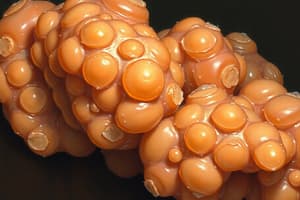Podcast
Questions and Answers
Which molecule is primarily utilized for lipogenesis in most mammals?
Which molecule is primarily utilized for lipogenesis in most mammals?
- Palmitate
- Acetate
- Glucose (correct)
- Fatty Acids
What is the end product of fatty acid synthesis?
What is the end product of fatty acid synthesis?
- Acetyl-CoA
- Free Palmitate (correct)
- Long-chain Hydrocarbons
- NADPH
Which factor primarily regulates the rate of lipogenesis?
Which factor primarily regulates the rate of lipogenesis?
- Hormone levels
- Age of the organism
- Nutritional state (correct)
- Physical activity levels
Where does fatty acid synthesis occur in the cell?
Where does fatty acid synthesis occur in the cell?
What type of chemical process is lipogenesis considered?
What type of chemical process is lipogenesis considered?
Which of the following is a substrate for fatty acid synthesis?
Which of the following is a substrate for fatty acid synthesis?
Which cofactors are required for the synthesis of fatty acids?
Which cofactors are required for the synthesis of fatty acids?
What must happen to acetyl-CoA before it can be used in fatty acid synthesis?
What must happen to acetyl-CoA before it can be used in fatty acid synthesis?
What is the primary function of acetyl-CoA carboxylase in fatty acid synthesis?
What is the primary function of acetyl-CoA carboxylase in fatty acid synthesis?
Which of the following components is essential for the activity of acetyl-CoA carboxylase?
Which of the following components is essential for the activity of acetyl-CoA carboxylase?
How is acetyl-CoA carboxylase regulated by the metabolite citrate?
How is acetyl-CoA carboxylase regulated by the metabolite citrate?
What effect does palmitoyl-CoA have on acetyl-CoA carboxylase activity?
What effect does palmitoyl-CoA have on acetyl-CoA carboxylase activity?
What is the source of CO2 that is utilized in the reaction catalyzed by acetyl-CoA carboxylase?
What is the source of CO2 that is utilized in the reaction catalyzed by acetyl-CoA carboxylase?
What happens to acetyl-CoA when it needs to be transferred from the mitochondria to the cytosol?
What happens to acetyl-CoA when it needs to be transferred from the mitochondria to the cytosol?
What happens to acetyl-CoA levels when energy is required, such as during fasting?
What happens to acetyl-CoA levels when energy is required, such as during fasting?
Which enzyme catalyzes the conversion of acetyl-CoA and oxaloacetate to citrate?
Which enzyme catalyzes the conversion of acetyl-CoA and oxaloacetate to citrate?
Which hormone inhibits acetyl-CoA carboxylase activity during energy deficit states?
Which hormone inhibits acetyl-CoA carboxylase activity during energy deficit states?
After citrate is cleaved in the cytosol, what are the two products formed?
After citrate is cleaved in the cytosol, what are the two products formed?
What are the subunits of acetyl-CoA carboxylase primarily composed of?
What are the subunits of acetyl-CoA carboxylase primarily composed of?
What is the fate of oxaloacetate in the cytosol once it is regenerated?
What is the fate of oxaloacetate in the cytosol once it is regenerated?
Which compound is required as a source of CO2 in the initial step of fatty acid synthesis?
Which compound is required as a source of CO2 in the initial step of fatty acid synthesis?
Which reaction is catalyzed by malate dehydrogenase in the cytosol?
Which reaction is catalyzed by malate dehydrogenase in the cytosol?
What is the role of malate after its formation in the cytosol?
What is the role of malate after its formation in the cytosol?
What initial step controls fatty acid synthesis?
What initial step controls fatty acid synthesis?
What is the main function of acetyl CoA carboxylase in fatty acid synthesis?
What is the main function of acetyl CoA carboxylase in fatty acid synthesis?
Which step in the fatty acid synthesis cycle follows the condensation of the growing chain with activated acetate?
Which step in the fatty acid synthesis cycle follows the condensation of the growing chain with activated acetate?
What is released during the condensation of acetyl-ACP and malonyl-ACP?
What is released during the condensation of acetyl-ACP and malonyl-ACP?
What is the role of NADPH in the synthesis of fatty acids?
What is the role of NADPH in the synthesis of fatty acids?
What molecule is produced at the end of the first round of fatty acid elongation?
What molecule is produced at the end of the first round of fatty acid elongation?
What occurs when palmitoyl-ACP is formed in the fatty acid synthesis process?
What occurs when palmitoyl-ACP is formed in the fatty acid synthesis process?
Which enzyme catalyzes the reduction of acetoacetyl-ACP to D-3-hydroxybutyryl-ACP?
Which enzyme catalyzes the reduction of acetoacetyl-ACP to D-3-hydroxybutyryl-ACP?
During fatty acid synthesis, what is the initial attachment of the growing chain to the enzyme based on?
During fatty acid synthesis, what is the initial attachment of the growing chain to the enzyme based on?
How many ATP molecules are consumed for each round of fatty acid elongation?
How many ATP molecules are consumed for each round of fatty acid elongation?
What is the primary function of malonyl-CoA in fatty acid synthesis?
What is the primary function of malonyl-CoA in fatty acid synthesis?
Which enzyme is responsible for the condensation reaction in fatty acid synthesis?
Which enzyme is responsible for the condensation reaction in fatty acid synthesis?
What is the product of 7 malonyl-CoA and 7 acetyl-CoA during fatty acid biosynthesis?
What is the product of 7 malonyl-CoA and 7 acetyl-CoA during fatty acid biosynthesis?
Which of the following is NOT a component of the enzyme complex responsible for introducing double bonds in fatty acids?
Which of the following is NOT a component of the enzyme complex responsible for introducing double bonds in fatty acids?
In which organelle does the elongation of fatty acids take place in eukaryotes?
In which organelle does the elongation of fatty acids take place in eukaryotes?
What is the maximum carbon position at which mammals can insert double bonds in a fatty acid chain?
What is the maximum carbon position at which mammals can insert double bonds in a fatty acid chain?
Which molecule is reduced during the seven cycles of fatty acid synthesis?
Which molecule is reduced during the seven cycles of fatty acid synthesis?
Flashcards
Fatty Acid Catabolism
Fatty Acid Catabolism
The process of breaking down fatty acids into smaller units, primarily for energy production.
Fatty Acid Biosynthesis (Lipogenesis)
Fatty Acid Biosynthesis (Lipogenesis)
The process of constructing fatty acids from smaller units.
Acetyl-CoA
Acetyl-CoA
The main substrate for lipogenesis, meaning it's the starting material for building fatty acids.
Palmitate
Palmitate
Signup and view all the flashcards
Cytosol
Cytosol
Signup and view all the flashcards
Lipogenesis
Lipogenesis
Signup and view all the flashcards
ATP
ATP
Signup and view all the flashcards
Nutritional State
Nutritional State
Signup and view all the flashcards
Fatty acid synthase (FAS)
Fatty acid synthase (FAS)
Signup and view all the flashcards
FAS cycle
FAS cycle
Signup and view all the flashcards
Allosteric regulation of acetyl CoA carboxylase
Allosteric regulation of acetyl CoA carboxylase
Signup and view all the flashcards
Acyl carrier protein (ACP)
Acyl carrier protein (ACP)
Signup and view all the flashcards
Condensation
Condensation
Signup and view all the flashcards
Reduction
Reduction
Signup and view all the flashcards
Dehydration
Dehydration
Signup and view all the flashcards
Reduction (second step)
Reduction (second step)
Signup and view all the flashcards
Acetyl-CoA Shuttle: Citrate as Transporter
Acetyl-CoA Shuttle: Citrate as Transporter
Signup and view all the flashcards
Re-generating Acetyl-CoA in the Cytosol
Re-generating Acetyl-CoA in the Cytosol
Signup and view all the flashcards
Oxaloacetate Conversion to Malate
Oxaloacetate Conversion to Malate
Signup and view all the flashcards
Malate-α-Ketoglutarate Transporter
Malate-α-Ketoglutarate Transporter
Signup and view all the flashcards
Malate's Role in NADPH Production
Malate's Role in NADPH Production
Signup and view all the flashcards
Formation of Malonyl-CoA: the Initial Step
Formation of Malonyl-CoA: the Initial Step
Signup and view all the flashcards
Bicarbonate as CO2 Source
Bicarbonate as CO2 Source
Signup and view all the flashcards
Acetyl-CoA Carboxylase
Acetyl-CoA Carboxylase
Signup and view all the flashcards
Acetyl-CoA carboxylase (ACC)
Acetyl-CoA carboxylase (ACC)
Signup and view all the flashcards
Malonyl-CoA
Malonyl-CoA
Signup and view all the flashcards
Production of Malonyl-CoA
Production of Malonyl-CoA
Signup and view all the flashcards
Citrate activation of ACC
Citrate activation of ACC
Signup and view all the flashcards
Palmitoyl-CoA inhibition of ACC
Palmitoyl-CoA inhibition of ACC
Signup and view all the flashcards
Hormonal regulation of ACC
Hormonal regulation of ACC
Signup and view all the flashcards
Regulation of acetyl-CoA carboxylase
Regulation of acetyl-CoA carboxylase
Signup and view all the flashcards
Fatty Acid Biosynthesis
Fatty Acid Biosynthesis
Signup and view all the flashcards
Fatty Acid Synthase
Fatty Acid Synthase
Signup and view all the flashcards
Condensation Reaction in Fatty Acid Synthesis
Condensation Reaction in Fatty Acid Synthesis
Signup and view all the flashcards
Fatty Acid Desaturation
Fatty Acid Desaturation
Signup and view all the flashcards
Desaturase
Desaturase
Signup and view all the flashcards
Limitations of Mammalian Desaturation
Limitations of Mammalian Desaturation
Signup and view all the flashcards
Dehydration Reaction
Dehydration Reaction
Signup and view all the flashcards
Study Notes
Fatty Acid Metabolism
- Fatty acid metabolism involves the breakdown and synthesis of fatty acids.
- Breakdown of fatty acids, also known as fatty acid catabolism, occurs when there is a scarcity of carbohydrates and energy.
- Synthesis of fatty acids, often called fatty acid biosynthesis, occurs when carbohydrates and energy are abundant.
Fatty Acid Breakdown (Catabolism)
- Fatty acid catabolism primarily takes place in mitochondria.
- It begins with the activation of fatty acids.
- The activated fatty acids undergo a cycle of beta-oxidation reactions, creating acetyl-CoA and reducing equivalents (NADH and FADH2).
Fatty Acid Synthesis (Anabolism)
- Fatty acid synthesis occurs in the cytosol.
- Acetyl-CoA is the initial substrate, and it shuttles into the cytosol from the mitochondria as citrate.
- Synthesis involves a series of reactions, using malonyl-CoA as a building block, to lengthen the fatty acid chain
- Involves reduction steps and utilizes NADPH as reducing agents.
Regulation of Fatty Acid Synthesis
- The main regulatory enzyme in fatty acid synthesis is acetyl-CoA carboxylase (ACC).
- ACC is allosterically regulated; citrate activates it, while palmitoyl-CoA inhibits it.
- Hormonal regulation also plays a key role: glucagon and epinephrine inhibit ACC, while insulin promotes it.
- Hormonal changes directly affect the activity of ACC to regulate the biosynthesis process.
Fatty Acid Synthase (FAS)
- FAS is a multifunctional enzyme.
- FAS catalyzes a repeating four-step sequence to elongate the fatty acid chain; it uses NADPH as the electron donor and two enzyme-bound -SH groups for activation.
- The first round of elongation produces butyryl-ACP; subsequently, the cycle repeats adding two carbons to the chain.
- This cycle continues until a 16-carbon palmitoyl-ACP is formed.
Key Molecules and Cofactors
- Acetyl-CoA, malonyl-CoA, citrate and fatty acid synthase are key players in fatty acid metabolism.
- Biotin, NADPH, and ATP are needed as cofactors in various steps.
- Some other cofactors needed for fatty acid synthesis are NADPH, ATP, Mn2+, biotin, and HCO3-.
Stoichiometry
- Synthesis of palmitate (16:0) involves specific steps requiring ATP and NADPH.
- The overall stoichiometry for palmitate synthesis is represented by a specific equation.
Formation of Double Bonds
- In eukaryotes, the smooth endoplasmic reticulum (SER) has enzymes that introduce double bonds into fatty acyl CoA molecules.
- This process utilizes molecular oxygen and a complex of three enzymes: NADH-cytochrome b5 reductase, cytochrome b5, and desaturase.
- Mammals lack the enzymes to introduce double bonds beyond carbon 9; hence, linoleate and linolenate are considered essential fatty acids.
Summary of differences between fatty acid catabolism and anabolism
- Catabolism occurs in the mitochondria and produces energy, while anabolism occurs in the cytosol and needs significant energy.
- Catabolism is exergonic (releases energy) and oxidative (oxidizes fatty acids); anabolism is endergonic (requires energy) and reductive (reduces fatty acids).
- Different coenzymes, electron carriers and locations in the cell are involved.
Studying That Suits You
Use AI to generate personalized quizzes and flashcards to suit your learning preferences.




